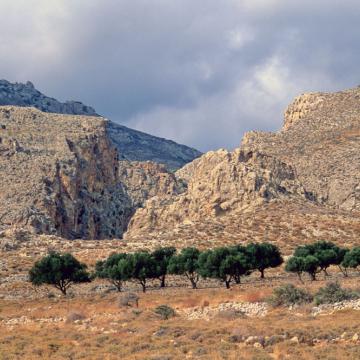GR4320009 - VOREIOANATOLIKO AKRO KRITIS
Map
Quality
The Vai palm forest is of unique importance for Europe. Phoenix theophrastii is one of the only two palms native in Europe (the other is at Canarian islands and very rare) and occurs outside Crete only locally in south-western Turkey. P. theophrastii might be a relict of the Tertiary European Phoenix which has persisted in some places with a favourite climate and where human activity has been low.The palm occurs at about another ten localities in Crete but always at small populations (maybe of only few individuals); the Vai forest is by far the largest palm grove in Crete and possibly in Europe.OTHER IMPORTANT SPECIES WITH MOTIVATION DRana ridibunda is protected by the Bern Convention (1992) and included in Annex V of the Directive 92/43/EEC. Chamaeleo chamaeleon is protected by the Bern Convention (1992) and by the Greek Law (Presidential Decree 67/81) and included in the National Red Data Book (rare) and also in Annex V of the Directive 92/43/EEC. Coluber gemonensis is protected by the Bern Convention (1992) and by the Greek Law. This is an important site for species associated with coastal cliffs and scrub and passage migrants. Species of concern include Falco naumanni, Falco eleonorae and Larus audouinii.
Other characteristics
The site comprises the Sideros peninsula, the palm forest of Vai, the coastal wetlands of Palekastro and islets of Elasa and Grantes, at the northeastern edge of Crete. The aesthetic forest of Vai is situated at the easternmost part of Crete; it is a wet, coastal forest and the largest palm forest in Crete. The Vai forest, which is under the management of the Ministry of Rural Development and Food, is fenced and it is visited by tourists.Inside the forest there is a spring with very low water supply and a stream. The palm is accompanied by an understorey of Nerium oleander along the watercourses. Towards the beach the palm is accompanied by very thin vegetation forming a small dune where the palm finds ideal growth conditions while inside the valley and mainly at the lowest places where the water level is higher there is a cover of Juncus sp. and Equisetum hiemalie where the palm is absent. At the edges of the valley there is a drier environment with phryganic vegetation (Coridothymus capitatus, Genista acanthoclada etc.) where the palm is at the limits of its ecological resistance. Natural regeneration of the palm trees (by seeds) is easy and abundant. Vegetative propagation is also easy.
Documentation
Heath, M. F. and Evans, M. I., eds. 2000. Important Bird Areas in Europe: Priority sites for conservation. 2: Southern Europe. Cambridge, UK: BirdLife International. BirdLife Conservation Series No. 8, p. 791.
Reference: Natura 2000 data form, database release 7 Feb 2014



